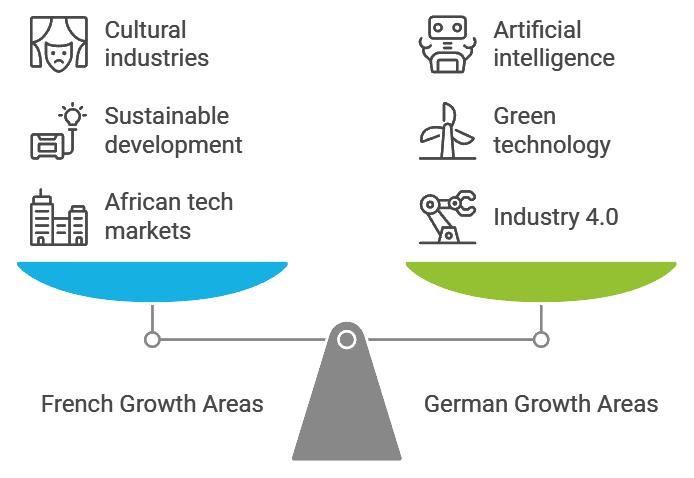Should you Learn French or German?
The choice between learning French or German depends on your career goals, location, and personal interests. In 2024, both languages offer unique advantages: French opens doors to a wider global community spanning multiple continents, while German provides strong opportunities in Europe’s largest economy and tech sector. Let’s explore which language might be your better choice.
Key Takeaways
- French speakers reach 267 million people across 29 countries
- German offers higher salary premiums (20-25% vs. 15-20% for French)
- Tech sector growth: German demand up 25%, French up 15%
- French shows faster global growth due to African market expansion
- Remote work opportunities growing faster for German (30% annually)
Global Reach and Impact
Think about where you see yourself in five years. Are you more interested in emerging markets or established European economies? Here’s what the numbers tell us:
| Aspect | French | German |
|---|---|---|
| Native Speakers | 80 million | 95 million |
| Total Speakers | 267 million | 155 million |
| Countries | 29 | 6 |
| Economic Regions | EU, Africa, Canada | EU, Central Europe |
| Growth Markets | Africa, Tech | Manufacturing, Engineering |
Career Opportunities
Want to know where the money is? Here’s how these languages stack up in different industries:
High-Paying Sectors for French
- Luxury goods (+22% salary premium)
- International development (+18%)
- Tourism and hospitality (+15%)
- Digital marketing (+17%)
Top German-Speaking Industries
- Engineering (+25% salary premium)
- Automotive (+23%)
- Software development (+22%)
- Financial technology (+20%)
Remote Work Revolution
Did you know that language skills can unlock global work opportunities? Here’s what’s happening in 2024:
| Work Type | French Demand | German Demand |
|---|---|---|
| Remote Full-Time | Growing 15% | Growing 30% |
| Freelance | Growing 20% | Growing 25% |
| Digital Nomad | Stable 10% | Growing 15% |
| Virtual Teams | Growing 18% | Growing 20% |
Learning Journey
How long will it take you to get job-ready? Here’s what the data shows:
Time to Business Proficiency
- French: 15 months (average)
- German: 18 months (average)
Online Learning Success Rates
- French courses: 68% completion
- German courses: 62% completion
Future Prospects
Looking ahead to 2030, here’s what experts predict:
Growth Areas for French
- African tech markets (+24%)
- Sustainable development
- Cultural industries
- E-commerce platforms
Growth Areas for German
- Industry 4.0 (+18%)
- Green technology
- Artificial intelligence
- Advanced manufacturing

Making Your Decision
Ask yourself these questions:
- Which regions interest you most?
- What industry do you work in (or aim to work in)?
- How much time can you invest in learning?
- Where do you want to live or work?
Success Factors to Consider
| Factor | French | German |
|---|---|---|
| Learning Curve | Moderate | Steeper |
| Job Markets | More Diverse | Higher Paying |
| Future Growth | Faster | Stable |
| Geographic Reach | Broader | Concentrated |
Getting Started Tips
Ready to begin? Here’s your action plan:
- Week 1-2
- Choose your learning platform
- Set realistic goals
- Create a study schedule
- Month 1
- Master basic greetings
- Learn numbers and essential phrases
- Join language exchange groups
- First 3 Months
- Complete beginner course
- Practice with native speakers
- Start consuming media in your chosen language
Pro Tip: Try both languages for two weeks each. Sometimes, personal connection matters more than practical benefits. Which one feels more natural to you?
Making It Work
Success strategies that apply to both languages:
- Study at least 30 minutes daily
- Use language learning apps consistently
- Find a language exchange partner
- Listen to podcasts in your target language
- Watch movies with subtitles
Remember, the “right” choice is the one you’ll stick with. Both French and German can transform your career and open new worlds of opportunity. The key is to choose the language that aligns with your goals and keeps you motivated.
Want to test the waters? Many online platforms offer free trials for both languages. Start there, and you’ll likely feel drawn to one language more than the other. Trust that instinct – it’s often the best guide to your learning journey.
